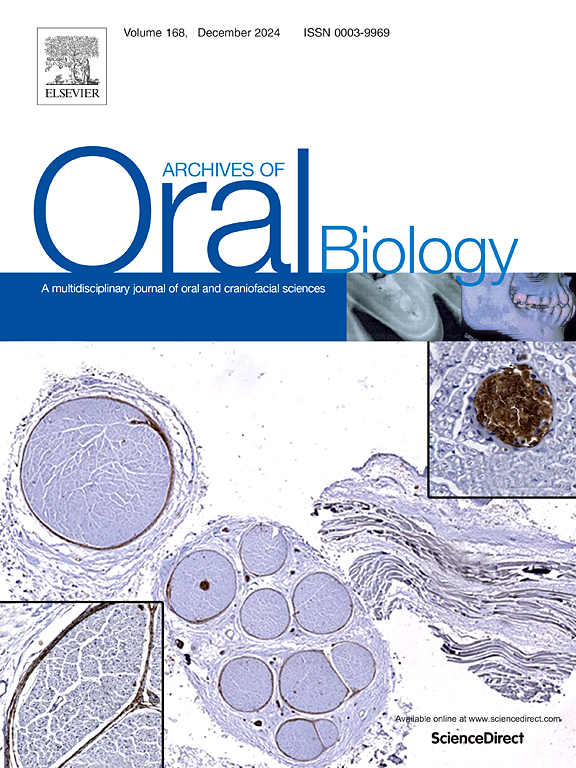Association of Epstein-Barr Virus and its clinical relevance in Human Papillomavirus-negative oral squamous cell carcinoma: A cohort study from South India
IF 2.2
4区 医学
Q2 DENTISTRY, ORAL SURGERY & MEDICINE
引用次数: 0
Abstract
Objective
The study assessed the prevalence and clinical implications of Epstein Barr Virus (EBV)-positive but Human Papillomavirus (HPV)-negative oral squamous cell carcinoma (OSCC) in a tertiary care hospital setting. The overall goal was to elucidate the potential impact of EBV on OSCC disease progression and prognosis.
Design
A total of 134 surgically resected and histopathologically confirmed OSCC tumor biopsies were collected from a tertiary care hospital. Tumor samples were analyzed for HPV and EBV using conventional and nested PCR. Clinical and demographic data, including age, sex, risk factors, tumor stage, and survival outcomes, were collected and analyzed to assess associations between EBV status and disease characteristics.
Results
All the tumor samples tested negative for HPV. However, EBV was detected in 74 cases (55.3 %) using nested PCR which was confirmed by sanger sequencing. EBV prevalence was higher in males (62.1 %), and the left buccal mucosa was the most affected site, accounting for 34 % of cases. Although statistically not significant, 63.5 % (n = 47) of the EBV positive subjects had a history of consuming both tobacco and alcohol. Of these 20 subjects showing recurrence, 35 % (n = 7) were EBV positive suggesting poor prognosis for EBV positive OSCC subjects.
Conclusion
This study highlights a significant prevalence of EBV in HPV-negative OSCC cases, suggesting a potential oncogenic role for EBV in OSCC progression, particularly in patients with established lifestyle risk factors. These findings underscore the need for further research into EBV's molecular mechanisms in OSCC and its utility as a biomarker for prognosis and therapeutic targeting. The results advocate for region-specific strategies to better understand and manage EBV-associated OSCC, offering potential pathways to improve outcomes in high-risk populations.
eb病毒与人乳头瘤病毒阴性口腔鳞状细胞癌的相关性及其临床意义:一项来自南印度的队列研究
目的:研究评估eb病毒(EBV)阳性但人乳头瘤病毒(HPV)阴性的口腔鳞状细胞癌(OSCC)在三级护理医院的患病率和临床意义。总体目标是阐明EBV对OSCC疾病进展和预后的潜在影响。设计:从一家三级医院收集了134例手术切除并经组织病理学证实的OSCC肿瘤活检。采用常规PCR和巢式PCR对肿瘤样本进行HPV和EBV检测。收集和分析临床和人口统计数据,包括年龄、性别、危险因素、肿瘤分期和生存结果,以评估EBV状态与疾病特征之间的关系。结果:所有肿瘤标本HPV检测均为阴性。然而,巢式PCR检测到EBV 74例(55.3% %),经sanger测序证实。男性EBV患病率较高(62.1% %),左颊粘膜是最受影响的部位,占34 %。虽然没有统计学意义,但63.5% % (n = 47)的EBV阳性受试者有烟酒双重消费史。在这20例复发患者中,35 % (n = 7)为EBV阳性,提示EBV阳性OSCC患者预后不良。结论:本研究强调了EBV在hpv阴性OSCC病例中的显著流行,表明EBV在OSCC进展中具有潜在的致癌作用,特别是在具有既定生活方式危险因素的患者中。这些发现强调了进一步研究EBV在OSCC中的分子机制及其作为预后和治疗靶向生物标志物的应用的必要性。研究结果提倡采取针对特定地区的策略,以更好地了解和管理ebv相关的OSCC,为改善高危人群的预后提供潜在途径。
本文章由计算机程序翻译,如有差异,请以英文原文为准。
求助全文
约1分钟内获得全文
求助全文
来源期刊

Archives of oral biology
医学-牙科与口腔外科
CiteScore
5.10
自引率
3.30%
发文量
177
审稿时长
26 days
期刊介绍:
Archives of Oral Biology is an international journal which aims to publish papers of the highest scientific quality in the oral and craniofacial sciences. The journal is particularly interested in research which advances knowledge in the mechanisms of craniofacial development and disease, including:
Cell and molecular biology
Molecular genetics
Immunology
Pathogenesis
Cellular microbiology
Embryology
Syndromology
Forensic dentistry
 求助内容:
求助内容: 应助结果提醒方式:
应助结果提醒方式:


